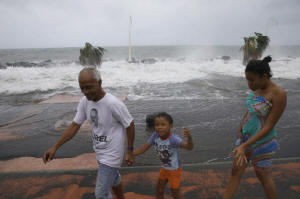|
Battering smaller islands, powerful
Hurricane Maria barrels toward Puerto Rico
 Send a link to a friend
Send a link to a friend
 [September 20, 2017]
By Alvin Baez and Robin Respaut [September 20, 2017]
By Alvin Baez and Robin Respaut
SAN JUAN, Puerto Rico (Reuters) - Hurricane
Maria, the second maximum-strength storm to hit the Caribbean this
month, battered the U.S. Virgin Island of St. Croix on Wednesday and
headed toward Puerto Rico, set to be the strongest storm to hit the
island in about 90 years.
Maria, packing catastrophic winds and causing surges, earlier killed at
least one person in the French territory of Guadeloupe and devastated
the tiny island nation of Dominica.
The storm hit just days after the region was punched by Hurricane Irma,
which ranked as one of the most powerful Atlantic storms on record and
left a trail of destruction on several Caribbean islands and the Florida
Keys.
Maria, a rare Category 5 storm at the top end of the five-step
Saffir-Simpson scale, was downgraded to a Category 4 storm as it neared
Puerto Rico, where it was set to make landfall in the morning. It was
packing maximum sustained winds near 155 mph (250 kph) and was 50 miles
(80 kms) southeast of San Juan, Puerto Rico, as of 5 a.m. EDT (0900
GMT), the U.S. National Hurricane Center (NHC).
A few hours earlier, Maria passed west of St. Croix, home to about half
of the U.S. Virgin Island's 103,000 residents, as a Category 5 storm and
its outer eyewall lashed the island with sustained winds of about 90 mph
(145 kph), the NHC said.

The center has hurricane warnings and watches out for the U.S. and
British Virgin Islands, Puerto Rico, Culebra, and Vieques, the Turks and
Caicos Islands, the southeastern Bahamas and the Dominican Republic from
Cabo Engano to Puerto Plata.
Many U.S. Virgin Islands residents fled to shelters around midday
Tuesday. U.S. Virgin Islands Governor Kenneth Mapp warned people on the
islands that their lives were at risk.
"The only thing that matters is the safety of your family, and your
children, and yourself. The rest of the stuff, forget it," he said.
Authorities expect to start assessing storm damage on St. Croix from
daybreak.
Maria will cross Puerto Rico later on Wednesday and pass just north of
the northeast coast of the Dominican Republic on Wednesday night and
Thursday, the NHC said.
It was too early to know if Maria will threaten the continental United
States as it moves northward in the Atlantic.
Earlier this month, Irma devastated several small islands, including
Barbuda and the U.S. and British Virgin Islands, and caused heavy damage
in Cuba and Florida, killing at least 84 people in the Caribbean and the
U.S. mainland.
DIRECT HIT
Maria was set to be the strongest hurricane to hit Puerto Rico since
1928, when the San Felipe Segundo hurricane made a direct hit on the
island and killed about 300 people, the National Weather Service said.
Maria will probably be a Category 4 when it makes landfall in Puerto
Rico, the NHC said. A slow weakening is expected after the hurricane
emerges over the Atlantic north of Puerto Rico and the Dominican
Republic, it added.
In Puerto Rico, Maria is expected to dump as much as 25 inches (63.5 cm)
of rain on parts of the island and bring storm surges, when hurricanes
push ocean water dangerously over normal levels, of up to 9 feet (2.74
m), the NHC said.
[to top of second column] |

People walk along a flooded seafront after the passage of Hurricane
Maria in Basse-Terre, Guadeloupe island, France, September 19, 2017.
REUTERS/Andres Martinez Casares

The heavy rainfall could cause life-threatening flash floods and
mudslides, it added.
"We have not experienced an event of this magnitude in our modern
history," Ricardo Rossello, governor of Puerto Rico, said in a
televised message on Tuesday.
"Although it looks like a direct hit with major damage to Puerto
Rico is inevitable, I ask for America’s prayers," he said, adding
the government has set up 500 shelters.
Puerto Rico, a U.S. territory of about 3.4 million people, avoided a
direct hit from Irma, but the storm knocked out power for 70 percent
of the island, and killed at least three people. Maria promises to
be worse.
"This is going to be catastrophic for our island," said Grisele
Cruz, who was staying at a shelter in the southeastern city of
Guayama. "We're going to be without services for a long time."
Puerto Rico is grappling with the largest municipal debt crisis in
U.S. history, with both its government and the public utility having
filed for bankruptcy protection amid fights with creditors.
More than 150 flights were canceled at the Luis Muñoz Marín
International Airport, the main international airport in Puerto
Rico, on Wednesday morning, according to tracking service
FlightAware.com.
'MIND-BOGGLING'
The storm plowed into Dominica, a mountainous country of 72,000
people, late on Monday causing what Prime Minister Roosevelt Skerrit
called "mind-boggling" destruction.
"The winds have swept away the roofs of almost every person I have
spoken to or otherwise made contact with," Skerrit said on Facebook,
saying that his own residence had been hit, too. He said he was now
focused on rescuing people who might be trapped and getting medical
help for the injured.

North of Dominica, the French island territory of Guadeloupe
appeared to have been hit hard. The Guadeloupe prefecture said one
person was killed by a falling tree and at least two people were
missing in a shipwreck.
Some roofs had been ripped off, roads were blocked by fallen trees,
80,000 households were without power and there was flooding in some
southern coastal areas, the prefecture said in Twitter posts.
(Additional reporting by Dave Graham in San Juan, Daina Beth Solomon
in Mexico City, Richard Lough in Paris, Anthony Deutsch in
Amsterdam, Robert Edison Sandiford in Bridgetown, Barbados, Writing
by Lisa Shumaker, Editing by Angus MacSwan)
[© 2017 Thomson Reuters. All rights
reserved.]
Copyright 2017 Reuters. All rights reserved. This material may not be published,
broadcast, rewritten or redistributed. |